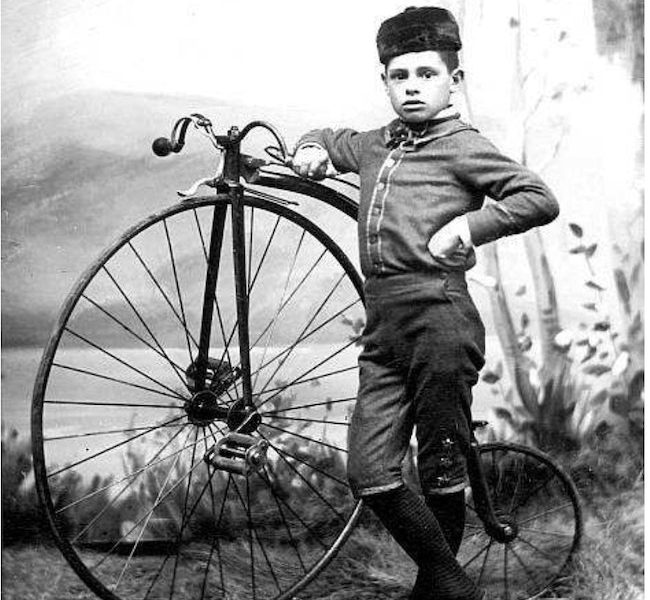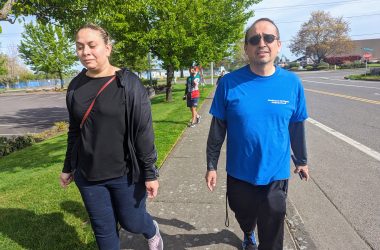
Ralph Emerson, son of Peter Emerson, in Salem in 1885 with a bicycle (Salem Public Library Historic Photograph Collections)
Sue Bell (1932-2019) for many years until her passing, wrote numerous local historical research articles for local newspapers and numerous Salem focused articles as the editor for Willamette Valley Genealogical Society’s quarterly, Beaver Briefs. This article appeared in part in BB Vol. 50, No. 1 and is reprinted in slightly edited form with permission.
What began as a fad has persisted to this day. With the cost of driving a vehicle currently, bicycles are even more important to personal transportation. Who hasn’t, as a youngster, asked Santa for a bike all their own? It’s almost a rite of passage into independence that young people learn to ride a bicycle.
Those early, early bicycles – called at the time, “walkalongs” – hardly qualified as bikes, though they did feature two wheels of equal size. Introduced in 1790, these early prototypes were strictly leg-powered with no pedals; riders simply perched on the wooden beam joining the wheels and walked atop the contraption. Twenty-six years later, a German inventor, Baron Karl Drais, improved the “dandy horse” or “swiftwalkers” with a steering bar connected to the front wheel.
In the 1860s two French tinkerers had the bright idea of attaching pedals to the front wheel of the bicycle to propel it. Pierre Lallement took out a patent on “the boneshaker” in 1866, the closest thing to today’s bike. The front wheel on this machine was slightly larger than the back one, though not as exaggeratedly outsized as the “high wheeler”, introduced in 1873 for English riders. Hard to balance because of the huge front wheel and the tiny back back one, the high wheeler soon prompted the creation of the “safety bicycle”, with brakes, adjustable handlebars, rubber tires, cushioned seats and ball bearings in the wheels.
The heyday for bikes in the United States was from 1889 to 1900; some four million riders took to the streets and roads of the country. Racing bicycles was a natural outgrowth of the new fad; the first such contest of record was in Massachusetts, 1883, and who doesn’t know of the Tour de France?
Oregon was not immune to the lure of biking, competing with horses and wagons along its paths and thoroughfares. Possibly the first notice of “velocipedes” in Salem appeared in the Willamette Farmer of March 15, 1869.
Seven months later, the Oregon Statesman editor vented on these new contraptions and their riders – calling them “Cayese boys” for their outrageous behavior around town and their lack of courtesy in cursing within the hearing of young women attracted to their antics.
Despite any adverse criticism, bicycling gained popularity and by the end of 1884, a riders club had been formed: the Chemeketa Bicycle Club, where talk of setting up a practice ring in the city was first broached.
Three years later bicyclists had become enough of a nuisance (if not a hazard) on Salem streets that on Oct. 3, 1887 Mayor Ramsey was sent an ordinance to regulate bicycles on the sidewalks, but he chose to veto the measure. The council upheld his veto.
 Post office employee Ben Taylor poses on his bicycle in this 1880 photo (Ben Maxwell Collection/Salem Public Library)
Post office employee Ben Taylor poses on his bicycle in this 1880 photo (Ben Maxwell Collection/Salem Public Library)
These early street bikes were of the “high wheeler” type: Ben Taylor of the post office staff, posed on his bike in 1888.
Early in July of 1890 Ben received a “safety bicycle” from the manufacturer.
Four years later, the craze had spread to such an extent that the city fathers deemed a race course in the city for bikers was appropriate and created one between the Capitol and the courthouse (later the site of the federal post office).
 An 1896 aerial view of Willson Park in Salem, also known as State Capital State Park.
An 1896 aerial view of Willson Park in Salem, also known as State Capital State Park.
This photograph of Willson park was taken from the capitol dome, looking west. The Marion County Courthouse, a quarter-mile bicycle racing track, and several fine residences show prominently. The racing track marks the site where the U.S. Post Office, now the Oregon Executive Department building, was to be constructed in 1903. Salem City Hall, at Chemeketa and High Streets, is under construction in the center background. The bicycle track reflects the popularity of the bicycle and the poor quality of streets and roads (the track had disappeared by May 21, 1901 when the cornerstone for the post office was laid).
As bike enthusiasts multiplied, more and more items of their exploits turned up in the local papers:
– A Stayton (Oregon) tinkerer, J. R. Miller, built his own bicycle and rode into Salem Aug. 6, 1894; the trip took for hours on 36″ wheels.
– Not to be outdone, less than a year later Fred Knapp rode his bike from McMinnville to Eugene – 111 miles – in a record nine hours and 26 minutes.
– What the Capital Journal, in April, 1895, called a “villainous act”, that of throwing tacks in the road to puncture bike tires, was noted “as mean a crime as could be committed short of bodily injury.”
– An ambitious undertaking was that of John McClure and Robert Huston to bicycle 300 miles to Burns, (Oregon), Huston’s old home; they estimated the trip would take five or six days.
– Such long-range touring was not unique: Bert Lucas of Polk county, set out with a party of young men for a bicycle trip across the European continent – in 1889! He sent letters home describing his travels and one appeared in the Oregon Statesman for July, 22 1889.
– A hill in Ulster County, New York, presented a mystery for bicyclists: it could be ascended easily on wheels but gravity refused to help the bike descend.
By summer 1895 the Daily Capital Journal actually had a column of “Bicycle Items” in their paper of interest to all biking enthusiasts.
As bikes proliferated, some regulation of their operation was called for; in summer 1895 the city council had outlawed all tricycles, tandems, bicycles or unicycles on city sidewalks from 5 a.m. to 10 p.m. The next spring wheelmen were also ordered to install lights on their machines.
New bicycle laws were announced on April 24, 1896: speed no more than 4 miles per hour; headlights and a “clear-toned” bell were required. Taxing and licensing of bikes followed in April of 1899 and the newspaper printed a lengthy list of those bicyclists who had paid their taxes as well as the make of their “wheels.”
 An ad in the May 23, 1900 Capital Journal for bicycles.
An ad in the May 23, 1900 Capital Journal for bicycles.
Bicycles are machines and therefore can and do break down. While agents sold bikes along with their other merchandise, repair and maintenance were somewhat neglected as a business until the mid-1890s when John Maurer was termed “local bicycle repairman.” (He is listed in the 1895 Census as a gunsmith. I could find no one in that Census who gave his occupation as a bicycle repairman, which is not to say some blacksmiths, mechanics or gunsmiths such as Maurer weren’t repairing the machines as a sidelight to their established businesses).
Maurer’s ad in the Capital Journal state he utilized a patented vulcanizer to repair wheels. A Portland repairman, William Mitchell, opened his bike shop at 288 Commercial Street in May, 1895; along with “making keys, repairing and re-covering umbrellas… making of all kinds of electrical machines and model-making”, he also specialized in repairing Imperial bikes
At any rate, by about 1897 Salem had a “Bicycle Hospital” devoted to bike repair “and general machine works” when L. E. Gardner and R. L. White established their repair shop.
Though it can no longer be called a “craze”, the bike has become an all-too-familiar scene on our streets with dedicated bike lanes on all thoroughfares and trendy fashion shops catering to riders (perhaps the first of these was a Halvorsen ad in March 1896 touting “equestrian tights for lady bikers.”) Tricked out currently with racing tires, gears and brakes on handlebars, tandem bikes or motorized ones, still the basic structure of two wheels, a seat, handlebars for steering and two pedals for propulsion remains as it was perfected a century and a half ago.
Editor’s note: This column is part of an effort from Salem Reporter to highlight local history in collaboration with area historians and historical organizations. If you have any feedback or would like to participate in Salem Reporter’s local history series, please contact managing editor Rachel Alexander at [email protected].
JUST THE FACTS, FOR SALEM – We report on your community with care and depth, fairness and accuracy. Get local news that matters to you. Subscribe to Salem Reporter starting at $5 a month. Click I want to subscribe!









